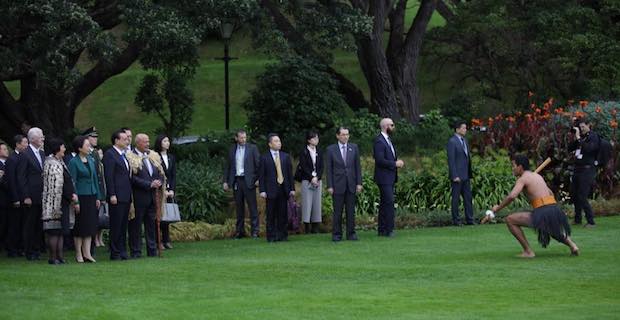New Zealand Trumps Australia on China... Again

In a love letter to New Zealand this week, the Chinese Premier Li Keqiang unintentionally exposed flaws in the Australia-China relationship. All nations pursue their interests by balancing strategic and economic policy and Canberra cannot engage with Beijing only on the latter.
Premier Li’s trip to Australia was overwhelmingly hailed a success, and it certainly seemed an exemplar of glitch-free diplomacy. Yet beyond a big win for beef exporters, the outcomes of the visit might be viewed as somewhat vanilla compared to the delights served up across the Tasman.
In Canberra, Trade Minister Steven Ciobo and Commerce Minister Zhong Shan agreed to a review of the China-Australia Free Trade Agreement (ChAFTA) in services and investment. In Wellington, Chinese officials and their Kiwi counterparts were getting prepped not just to review, but to upgrade an FTA that both sides have benefitted from since 2008—six years before the ChAFTA was signed.
It was Premier Li’s first visit to New Zealand, and in his New Zealand Herald op-ed, Li aptly recalled a number of other important firsts: New Zealand was the first developed country to formally agree to China’s World Trade Organization accession; the first to recognise China as a market economy; the first to conclude an FTA with China; the first to hold a nationwide Chinese Language Week and the first to join the Asian Infrastructure Investment Bank (AIIB).
One would think the Australian government might have learned from the mistake of hesitating on joining the AIIB, yet a case of deja vu unfolded last week with reports that Australia declined an offer to formally link itself to China’s One Belt One Road (OBOR) initiative. The Financial Times ran the headline, ‘Australia rejects China push on Silk Road strategy’, which was subtitled: ‘Canberra fears tying infrastructure fund to Beijing’s plans would hit US relations’.
In a joint press conference with Foreign Minister Julie Bishop on 7 February, Chinese Foreign Minister Wang Yi said ‘We intend to link China’s Belt Road initiative with Australia’s vision for developing Northern Australia’. A mere six weeks later it is hard to understand why we would distance ourselves from the prospect.
Thanks to Australian ambivalence New Zealand can now add another crucial notch to its belt: it is the first Western country to sign a cooperation agreement with China on OBOR.
The merits or perils of OBOR are widely contested and the initiative is plagued with ambiguity both within and outside of China. Foreign policy experts question whether OBOR is an economic plan or a new branch of strategic reach. According to a Lowy Institute report by Peter Cai, it is surely a combination of the two. Nonetheless, Shadow Minister for Foreign Affairs Penny Wong recently argued, “We need a policy that looks at the Belt and Road initiative with an eye to identifying points of mutual interest and complementarity rather than reflexive negativity”.
As China’s might increases, it will be difficult to divorce trade and investment policies from its broader arc of influence. RAND Corporation’s Timothy Heath states that globalisation coupled with China’s sheer power means “China’s development is revising the status quo whether Beijing intends it or not”.
Jane Golley, David Murphy and Michael Wesley at the Australian National University have argued that OBOR exemplifies “a new type of geoeconomics“, that is, “the intertwining of geopolitical and economic statecraft”. Australia must adapt to this approach as it comes to “dominate the international affairs of Asia in the twenty-first century”.
If Australia steps back every time China presents an economic opportunity, waiting to see whether it includes strategic intent, we are likely to miss out entirely. All nations pursue their interests by balancing strategic and economic policy, to pretend we have the luxury of engaging with China only on the latter is naive.
Whether OBOR represents a grand strategy, or if such a strategy would even be successful, remains to be seen. Meanwhile there are tangible infrastructure projects currently underway and growing evidence of opportunities for Australia and our regional neighbours.
Economist Dr Huw McKay of BHP Billiton estimates that OBOR is more than seven times the size of the Marshall Plan, including adjustments for inflation, with some US$1.3 trillion (AU$1.7 trillion) worth of projects already initiated. It should be noted, however, that OBOR has been retroactively applied to a number of these projects in an effort to rebrand and claim credit for pre-existing ventures.
Even if OBOR is no more than a marketing exercise it seems to be effective. Cai observes that “All levels of the Chinese government, from the national economic planning agency to provincial universities, are scrambling to get involved in OBOR. Nearly every province in China has developed its own OBOR plan to complement the national blueprint.”
China is introducing mechanisms to facilitate the immense task of shifting its economy away from manufacturing towards consumption. In the past 15 years, hourly manufacturing wages in China have increased by an average 12 per cent per year. China aims to migrate production facilities and reorient supply chains as its reserve of cheap labour dwindles. To do so it must encourage neighbouring economies to reform and develop. OBOR is key to China’s economic plans and Australia must swiftly decide whether it wants to be included.
While Li’s visit to Australia carried an aura of accomplishment, we cannot ignore the reality that there is always more to be done. New Zealand clearly recognises this. Australia must emerge from complacency and delve deeper into a relationship that it cannot afford to take for granted.
Hannah Bretherton is a project coordinator and researcher at China Matters. Follow her at @hcbretherton
This article is published under a Creative Commons Licence and may be republished with attribution.





